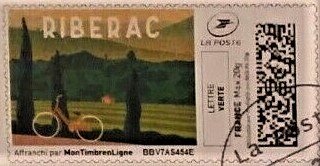Stamp: Riberac (Personalized and Private Mail Stamps 2020)
Riberac (Personalized and Private Mail Stamps 2020)
01 January (Personalized and Private Mail Stamps ) within release France : TimbrEnLIgne. Bicycle goes into circulation Stamp Riberac face value 20 Gram
| Stamp Riberac in catalogues | |
|---|---|
| Colnect codes: | Col: FR-TIM 2020-127 |
Stamp is square format.
Also in the issue France : TimbrEnLIgne. Bicycle:
- Stamp - Ribeauville face value 20;
- Stamp - Alpes face value 20;
- Stamp - Riberac face value 20;
- Stamp - Ile de Re face value 20;
- Stamp - Montpellier face value 20;
- Stamp - Family on the Sea Front face value 20;
- Stamp - Pyrenees face value 20;
- Stamp - Bordeaux face value 20;
- Stamp - Ile de Oleron face value 20;
- Stamp - Girl on a Bike in a Green Field face value 20;
- Stamp - Girl Pushing a Bike at the Seaside face value 20;
- Stamp - Cycling in the Countryside face value 20;
- Stamp - Cyclists on a Tandem in a Green Field face value 20;
- Stamp - Cyclist on a Mountain face value 20;
- Stamp - Cyclist in Town face value 20;
- Stamp - Bicycle in the Mountains face value 20;
- Stamp - Rapide No 1 Fixie face value Lettre;
- Stamp - Delivery Bike. Tricycle. Pratique No 2 Triporteur face value Lettre;
- Stamp - Dynamique No 3 Velo Electrique face value Lettre;
- Stamp - Convivial No 4 Tandem face value 20;
- Stamp - Agreable No 5 Velo Citadin face value Lettre;
- Stamp - Post Bike Utile No 6 Velo Facteur face value Lettre;
- Stamp - Robuste No 7 VTT face value 20;
- Stamp - Moped Biker No 8 Velo Moteur face value Lettre;
- Stamp - Bordeaux Clock Tower face value 20;
- Stamp - Sunset at the Beach. Bicycle face value 20;
- Stamp - Cyclist on a Mountain face value 100;
- Stamp - Cyclists on a Tandem face value 20;
|
Data entry completed
46%
|
|
|---|---|
| Stamp Riberac in digits | |
| Country: | Personalized and Private Mail Stamps |
| Date: | 2020-01-01 |
| Emission: | Personalized - Official |
| Format: | Stamp |
| Face Value: | 20 Gram |
Stamp Riberac it reflects the thematic directions:
A bicycle, also called a pedal cycle, bike, push-bike or cycle, is a human-powered or motor-assisted, pedal-driven, single-track vehicle, with two wheels attached to a frame, one behind the other. A bicycle rider is called a cyclist, or bicyclist.
Cycling, also known as bicycling or biking, is the activity of riding a bicycle or other type of cycle. It encompasses the use of human-powered vehicles such as balance bikes, unicycles, tricycles, and quadricycles. Cycling is practised around the world for purposes including transport, recreation, exercise, and competitive sport.
A landscape is the visible features of an area of land, its landforms and how they integrate with natural or man-made features. A landscape includes the physical elements of geophysically defined landforms such as (ice-capped) mountains, hills, water bodies such as rivers, lakes, ponds and the sea, living elements of land cover including indigenous vegetation, human elements including different forms of land use, buildings and structures, and transitory elements such as lighting and weather conditions. Combining both their physical origins and the cultural overlay of human presence, often created over millennia, landscapes reflect a living synthesis of people and place that is vital to local and national identity. The character of a landscape helps define the self-image of the people who inhabit it and a sense of place that differentiates one region from other regions. It is the dynamic backdrop to people’s lives. Landscape can be as varied as farmland, a landscape park, or wilderness. The earth has a vast range of landscapes, including the icy landscapes of polar regions, mountainous landscapes, vast arid desert landscapes, islands and coastal landscapes, densely forested or wooded landscapes including past boreal forests and tropical rainforests, and agricultural landscapes of temperate and tropical regions.
In botany, a tree is a perennial plant with an elongated stem, or trunk, supporting branches and leaves in most species. In some usages, the definition of a tree may be narrower, including only woody plants with secondary growth, plants that are usable as lumber or plants above a specified height. Trees are not a taxonomic group but include a variety of plant species that have independently evolved a woody trunk and branches as a way to tower above other plants to compete for sunlight. In looser senses, the taller palms, the tree ferns, bananas and bamboos are also trees. Trees tend to be long-lived, some reaching several thousand years old. The tallest known tree, a coast redwood named Hyperion, stands 115.6 m (379 ft) high. Trees have been in existence for 370 million years. It is estimated that there are just over 3 trillion mature trees in the world. A tree typically has many secondary branches supported clear of the ground by the trunk. This trunk typically contains woody tissue for strength, and vascular tissue to carry materials from one part of the tree to another. For most trees it is surrounded by a layer of bark which serves as a protective barrier. Below the ground, the roots branch and spread out widely; they serve to anchor the tree and extract moisture and nutrients from the soil. Above ground, the branches divide into smaller branches and shoots. The shoots typically bear leaves, which capture light energy and convert it into sugars by photosynthesis, providing the food for the tree's growth and development. Flowers and fruit may also be present, but some trees, such as conifers, instead have pollen cones and seed cones; others, such as tree ferns, produce spores instead. Trees play a significant role in reducing erosion and moderating the climate. They remove carbon dioxide from the atmosphere and store large quantities of carbon in their tissues. Trees and forests provide a habitat for many species of animals and plants. Tropical rainforests are one of the most biodiverse habitats in the world. Trees provide shade and shelter, timber for construction, fuel for cooking and heating, and fruit for food as well as having many other uses. In parts of the world, forests are shrinking as trees are cleared to increase the amount of land available for agriculture. Because of their longevity and usefulness, trees have always been revered, with sacred groves in various cultures, and they play a role in many of the world's mythologies.




